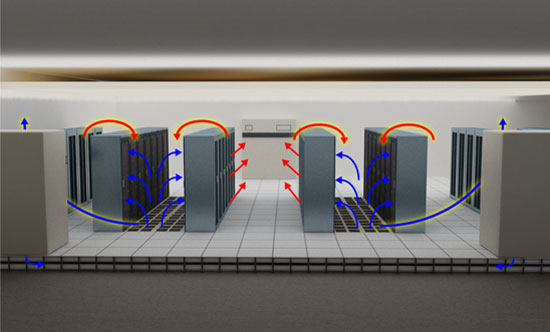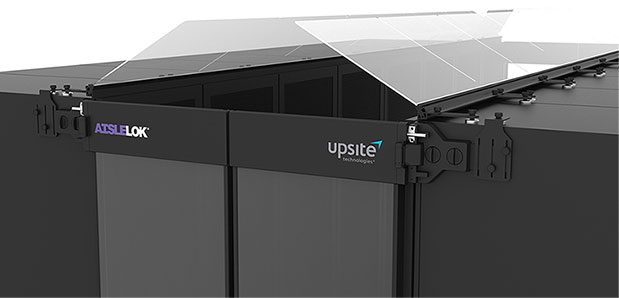Engineering the Best Hot / Cold Aisle Containment Strategies for your Data Center
“The most obvious solution isn’t always the best solution”
Data center containment strategies (both hot aisle and cold aisle) have gained a number of proponents over the past few years, and are now widely regarded as the starting point for energy efficiency best practices in the server room. With all this talk of containment, you might be wondering which approach is best for your data center.
While industry authorities stress any containment is better than none at all, there’s considerable debate between manufacturers, consultants, and end users about the “best” containment approach. In reality, the “best” containment strategy will largely depend on the application itself. Each unique server room will require a unique solution. Some environments will benefit more from hot aisle containment, while others may be limited to cold aisle containment due to physical constraints.
Most important, despite what the experts say, improperly implemented containment can be as bad or worse than no containment at all. Availability can be seriously compromised when airflow dynamics and pressure differentials are not properly accounted for.
| Aisle Containment DOs | Aisle Containment DON’Ts |
|---|---|
|
|
View the full Do’s and Dont’s of Aisle Containment Webinar
Why Aisle Containment? An Overview
At their most basic, hot aisle and cold aisle containment are refinements of the now standard hot aisle / cold aisle layout found in most data centers. Hot aisle / cold aisle server rack layouts were conceived as a strategy for more efficient cooling of the data center. In this type of server room layout, each successive aisle is designated either a hot aisle or cold aisle. In the cold aisles, the server racks are aligned so equipment inlets are facing each other on opposite sides. In the next aisle, both banks of server racks exhaust hot air.
In the typical implementation, cool air from the Computer Room Air Conditioner (CRAC) or Computer Room Air Handler (CRAH) flows under a raised floor system, also called a plenum, to perforated floor tiles. These tiles, only located in cold aisles, allow the cooling air to reach the server inlets in the front of the racks, flow through the IT equipment, and exhaust into the hot aisle.
In theory, hot aisle / cold aisle layouts increase energy efficiency by allowing for higher temperature set points by directing cooler air closer to equipment inlets. By concentrating the cooling air where it is needed most, CRAC / CRAH units can run a few degrees higher than would otherwise be necessary. While modest effectiveness gains are realized by delivering cool air to the proper side of the equipment, hot aisle / cold aisle layouts still present challenges in today’s high-density rack environment. Foremost being: “bypass air”, where cool air fails to enter the IT equipment; and “recirculation”, where heated exhaust air flows back into the cold aisle over the tops of the rack or through open rack space. Both of these conditions may lead to data center hot spots and the need for lower temperature set points and significant cooling over-capacity.

The Birth of Aisle Containment
In response to these challenges, data center operators began to contain either their hot or cold aisles. The first containment strategies used plastic sheeting and even cardboard boxes to build barriers around the cold aisle. The sheeting was hung as doors across the aisle walkways and over the tops of cabinets as ceilings to reduce bypass and recirculation issues. While this crude solution improved airflow dynamics, it created new headaches by blocking fire suppression systems and hindering workflow. Since these modest beginnings, aisle containment has come of age with manufacturers supplying a wide range of hot aisle and cold aisle containment solutions including aisle containment curtains with fusible links that meet local fire codes. Sifting through the myriad of options and choosing the right containment strategy can be a daunting task.
Hot Aisle Containment
The goal of hot aisle containment is to capture the hot exhaust from IT equipment and direct it to the CRAC or CRAH units as quickly as possible.
Mainly two types of systems achieve containment: the “room” or the “chimney”.Similar to cold aisle containment, the “room” method seeks to separate the hot aisle with barriers made from curtains, or metal enclosures. The “chimney” method uses special server racks with chimneys to direct hot exhaust into the return air system or overhead plenum.
Hot aisle containment is an excellent option for new data center builds and those with existing hot air return ducts or over-ceiling plenum space. Be sure to consider local fire and building codes before implementation, as proper fire suppression must be taken into account. Also, be aware of pressure differentials between contained aisles and the rest of the data center.
Hot Aisle Containment Snapshot:
- Good for new data centers and environments with existing hot air return systems
- Density supported dependent on overall server room environment
- Important Considerations
- Return air ductwork or over-ceiling space in place
- Hotter working conditions in contained aisle
- High static pressure can lead to lower air flow and icing of cooling coils
- Local fire codes may impact implementation
- Possible local, state, and federal rebate availability
Cold Aisle Containment
As the name implies, cold aisle containment attempts to isolate the cold air in a “room” of its own. By using containment curtains, metal, or other similar barrier, the cooling air is concentrated at the equipment intake. The cold air must pass through the server racks, cooling the equipment, before entering the rest of the room.
Clearly, the focus of cold aisle containment is to cool the IT equipment, not the whole room, with targeted cooling at the equipment inlet.
Cold Aisle containment can be a cost effective approach for older data centers with open-room hot air return schemes. Be sure to consider the cooling needs of non-contained IT equipment and airflow dynamics of the raised floor system. As with hot-aisle containment, be sure to consult local fire and building codes to determine proper fire suppression needs to avoid costly fines and voiding of insurance policies.
Cold Aisle Containment Snapshot:
- Good for existing data centers without hot air return
- Focuses on cooling IT equipment not entire room
- Density supported dependent on overall server room environment
- Important Considerations
- Raised floor airflow dynamics
- Less cool air (hence, less ride-through time)
available in event of cooling or power failure - Higher ambient room temperatures
- Additional cooling may be necessary for un-contained IT equipment
- Local fire codes may impact implementation
- Possible local, state, and federal rebate availability
Containment Solutions
42U’s containment solutions support both cold-aisle and hot-aisle segregation depending on the unique requirements of your data center. 42U’s engineers will help you create a cost effective containment system, tailored to your data center, which optimizes data center airflow and maximizes cooling capacity.
Starting with a detailed analysis of IT cooling needs and CRAC / CRAH capacities, 42U’s engineers determine the cooling load born by each CRAC / CRAH unit, locate hot-spots and areas of over-cooling, and evaluate existing infrastructure to determine the most practical containment strategy for your data center or server room including expected return on investment. Once the proper strategy has been determined, 42U can help you ensure proper implementation to maximize the return on your investment.
When properly implemented, containment users typically realize immediate energy savings making them eligible in certain geographies for utility rebates. In addition to designing and installing your containment system, 42U can engage your energy provider to determine your rebate eligibility. Keep in mind rebates generally need pre-approval from utility companies, and it is important to engage the rebating authority at the beginning of a containment project.








